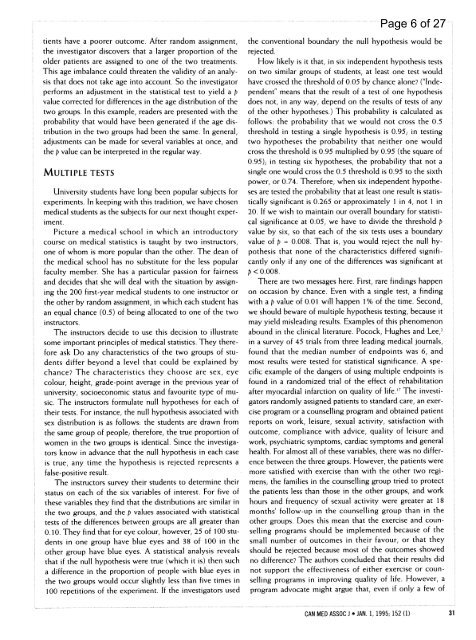CMAJ 1995 Basic Statistics for Clinicians
CMAJ 1995 Basic Statistics for Clinicians
CMAJ 1995 Basic Statistics for Clinicians
You also want an ePaper? Increase the reach of your titles
YUMPU automatically turns print PDFs into web optimized ePapers that Google loves.
tients have a poorer outcome. After random assignment,<br />
the investigator discovers that a larger proportion of the<br />
older patients are assigned to one of the two treatments.<br />
This age imbalance could threaten the validity of an analysis<br />
that does not take age into account. So the investigator<br />
per<strong>for</strong>ms an adjustment in the statistical test to yield a p<br />
value corrected <strong>for</strong> differences in the age distribution of the<br />
two groups. In this example, readers are presented with the<br />
probability that would have been generated if the age distribution<br />
in the two groups had been the same. In general,<br />
adjustments can be made <strong>for</strong> several variables at once, and<br />
the p value can be interpreted in the regular way.<br />
MULTIPLE TESTS<br />
University students have long been popular subjects <strong>for</strong><br />
experiments. In keeping with this tradition, we have chosen<br />
medical students as the subjects <strong>for</strong> our next thought experiment.<br />
Picture a medical school in which an introductory<br />
course on medical statistics is taught by two instructors,<br />
one of whom is more popular than the other. The dean of<br />
the medical school has no substitute <strong>for</strong> the less popular<br />
faculty member. She has a particular passion <strong>for</strong> fairness<br />
and decides that she will deal with the situation by assigning<br />
the 200 first-year medical students to one instructor or<br />
the other by random assignment, in which each student has<br />
an equal chance (0.5) of being allocated to one of the two<br />
instructors.<br />
The instructors decide to use this decision to illustrate<br />
some important principles of medical statistics. They there<strong>for</strong>e<br />
ask Do any characteristics of the two groups of students<br />
differ beyond a level that could be explained by<br />
chance? The characteristics they choose are sex, eye<br />
colour, height, grade-point average in the previous year of<br />
university, socioeconomic status and favourite type of music.<br />
The instructors <strong>for</strong>mulate null hypotheses <strong>for</strong> each of<br />
their tests. For instance, the null hypothesis associated with<br />
sex distribution is as follows: the students are drawn from<br />
the same group of people; there<strong>for</strong>e, the true proportion of<br />
women in the two groups is identical. Since the investigators<br />
know in advance that the null hypothesis in each case<br />
is true, any time the hypothesis is rejected represents a<br />
false-positive result.<br />
The instructors survey their students to determine their<br />
status on each of the six variables of interest. For five of<br />
these variables they find that the distributions are similar in<br />
the two groups, and the p values associated with statistical<br />
tests of the differences between groups are all greater than<br />
0.10. They find that <strong>for</strong> eye colour, however, 25 of 100 students<br />
in one group have blue eyes and 38 of 100 in the<br />
other group have blue eyes. A statistical analysis reveals<br />
that if the null hypothesis were true (which it is) then such<br />
a difference in the proportion of people with blue eyes in<br />
the two groups would occur slightly less than five times in<br />
100 repetitions of the experiment. If the investigators used<br />
Page 6 of 27<br />
the conventional boundary the null hypothesis would be<br />
rejected.<br />
How likely is it that, in six independent hypothesis tests<br />
on two similar groups of students, at least one test would<br />
have crossed the threshold of 0.05 by chance alone? ("Independent"<br />
means that the result of a test of one hypothesis<br />
does not, in any way, depend on the results of tests of any<br />
of the other hypotheses.) This probability is calculated as<br />
follows: the probability that we would not cross the 0.5<br />
threshold in testing a single hypothesis is 0.95; in testing<br />
two hypotheses the probability that neither one would<br />
cross the threshold is 0.95 multiplied by 0.95 (the square of<br />
0.95); in testing six hypotheses, the probability that not a<br />
single one would cross the 0.5 threshold is 0.95 to the sixth<br />
power, or 0.74. There<strong>for</strong>e, when six independent hypotheses<br />
are tested the probability that at least one result is statistically<br />
significant is 0.265 or approximately 1 in 4, not I in<br />
20. If we wish to maintain our overall boundary <strong>for</strong> statistical<br />
significance at 0.05, we have to divide the threshold p<br />
value by six, so that each of the six tests uses a boundary<br />
value of p = 0.008. That is, you would reject the null hypothesis<br />
that none of the characteristics differed significantly<br />
only if any one of the differences was significant at<br />
p
















